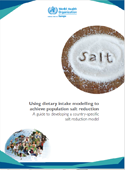Using dietary intake modelling to achieve population salt reduction - A guide to developing a country-specific salt reduction model (2018)

Download
The amount of sodium (in the form of salt) consumed in Europe exceeds levels recommended by the World Health Organization (WHO). Excess sodium intake causes raised blood pressure and thereby increases the risk of cardiovascular diseases – namely, stroke and coronary heart disease. Many countries in the WHO European Region have initiated national sodium reduction strategies, including reformulation, interpretative front-of-pack labelling, and behaviour change communication. Nevertheless, more concerted action is needed. This policy brief provides guidance for countries on how to identify the specific sources of sodium in the diet and how to calculate their relative contribution to overall sodium intake. Based on this, a theoretical “salt reduction model” can be developed in countries. Such a model can help determine the level of reduction needed in the sodium content of food product categories that are the main contributors to salt intake, including discretionary salt, in order to achieve a significant reduction in population salt intake.



